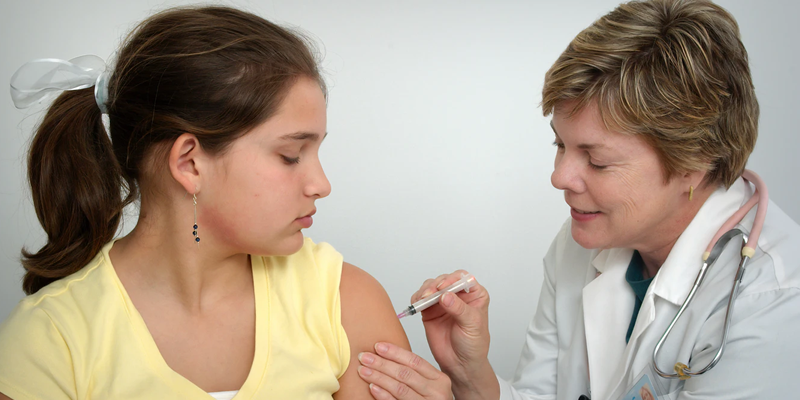HPV and Related Cancers: Questions and Facts

By: Brie Veltri, Health Program Specialist, Idaho Department of Health and Welfare
What is HPV?
HPV, or Human Papillomavirus, is the most common sexually transmitted infection in the U.S. It is a common virus that causes most cases of cervical cancer, as well as vulvar and vaginal cancer in women, anal and penile cancer in men, and throat cancer and genital warts in men and women. For most people, HPV clears on its own. But, for others who don’t clear the virus, it could cause certain cancers and diseases.
How is it contracted and how does it affect me?
- HPV is contracted through skin to skin contact with infected individuals.
- About 14 million new HPV infections occur every year in the US.
- HPV if not treated can go on to cause cancers later in life. This includes oropharyngeal, anal, cervical, vaginal, vulvar, and penile cancers.
Ways to prevent HPV and other related cancers:
- HPV vaccination is a form of cancer prevention for both males and females.
- It’s important to vaccinate before potential exposure to cancer-causing HPV types
- The best way to prevent HPV is to get vaccinated.
- For individuals 9 through 14 years of age, GARDASIL 9 can be administered using a 2-dose or 3-dose schedule. For the 2-dose schedule, the second dose should be administered 6–12 months after the first dose. If the second dose is administered less than 5 months after the first dose, a third dose should be given at least 4 months after the second dose. For the 3-dose schedule, GARDASIL 9 should be administered at 0, 2 months, and 6 months.
- For individuals 15 through 45 years of age, GARDASIL 9 is administered using a 3-dose schedule at 0, 2 months, and 6 months.

Getting Vaccinated:
- Children: The HPV vaccine is a routine recommendation for both males and females ages 9-26.
- Earlier is better. We see that once children enter their teen years it is harder to get them into see a provider due to conflicting interest with school, sports, extra-circulars, etc.
- It CAN’T wait. Vaccinate before exposure or the vaccine is not effective.
- Adults: In 2019 CDC released vaccine to adults ages 27-45 as shared decision making.
- Vaccination can help protect against certain cancers caused by other HPV types you have not been exposed to yet. Infection with one type of HPV does not prevent infection with another type.
- It can still be beneficial to most people. Talk with your health care provider to see if you should receive the vaccine.
- Most insurance cover vaccinations. Check with your insurance provider to see if it is covered.
Facts:
- As of 2019, only 45.9% of Idaho girls and 41.0% of Idaho boys had been vaccinated for HPV (IRIS).
- HPV vaccination is most effective if administered at the age of 11 or 12.
- April 11-17 is National Oral, Head, and Neck Cancer Awareness Week.
Additional Resources:
HPV Free Idaho
If there were a vaccine to prevent cancer, would you get it for your children? Of course you would.
- The HPV vaccine IS cancer prevention.
- The HPV vaccine is very important because it PREVENTS cancer. No child dreams of being a cancer patient. The HPV vaccine is cancer prevention.
- The best way to prevent HPV-associated cancers is to have your sons and daughters completely vaccinated against HPV. The HPV vaccine is most effective when given between 11-12 years of age when the body will produce the best immune response to develop protection before coming in contact with the virus.
- Research has shown that getting the HPV vaccine does not make kids more likely to be sexually active or start having sex at a younger age.
- We vaccinate so that children have the best protection possible long before they are exposed to an infection, as is the case with measles and the other recommended childhood vaccines.
- A missed opportunity is a healthcare encounter where a person does not receive a vaccination for which he or she is eligible.
- Currently 79 million Americans are infected with HPV, increasing at a rate of approximately 14 million new cases each year in the U.S. In the U.S., 33,000 HPV-associated cancers are diagnosed yearly, about 20,600 among females and 12,600 among males.
- Cervical cancer is the most common HPV-associated cancer among females and oropharyngeal cancers are the most common among males. Of the 33,000 new HPV-associated cancers that occur each year, it is estimated that about 26,000 could be prevented through HPV vaccination.
Unfortunately, there is no cure for HPV. It can only be prevented.
- Centers for Disease Control and Prevention (CDC). Human papillomavirus. In: Hamborsky J, Kroger A, Wolfe C, eds. Epidemiology and Prevention of Vaccine-Preventable Diseases. 13th ed. Washington DC: Public Health Foundation; 2015:175-186.
- Centers for Disease Control and Prevention (CDC). HPV and oropharyngeal cancer. https://www.cdc.gov/std/hpv/stdfact-hpv.htm. Last reviewed March 14, 2018. Accessed January 21, 2020.
- Centers for Disease Control and Prevention (CDC). 2015 sexually transmitted diseases treatment guidelines: human papillomavirus (HPV) infection. https://www.cdc.gov/std/tg2015/hpv.htm. Last reviewed June 4, 2015. Accessed February 3, 2020.
- Centers for Disease Control and Prevention (CDC). Types of cancer caused by HPV. https://www.cdc.gov/hpv/parents/cancer.html. Last reviewed April 29, 2019. Accessed March 9, 2020.
- Centers for Disease Control and Prevention (CDC). STD Facts – HPV and Men. https://www.cdc.gov/std/hpv/stdfact-hpv-and-men.htm. Last reviewed December 28, 2016. Accessed January 28, 2020.
- Centers for Disease Control and Prevention (CDC). Genital HPV Infection – Fact Sheet. https://www.cdc.gov/std/hpv/stdfact-hpv.htm. Last reviewed August 20, 2019. Accessed October 23, 2019.
 Official Government Website
Official Government Website